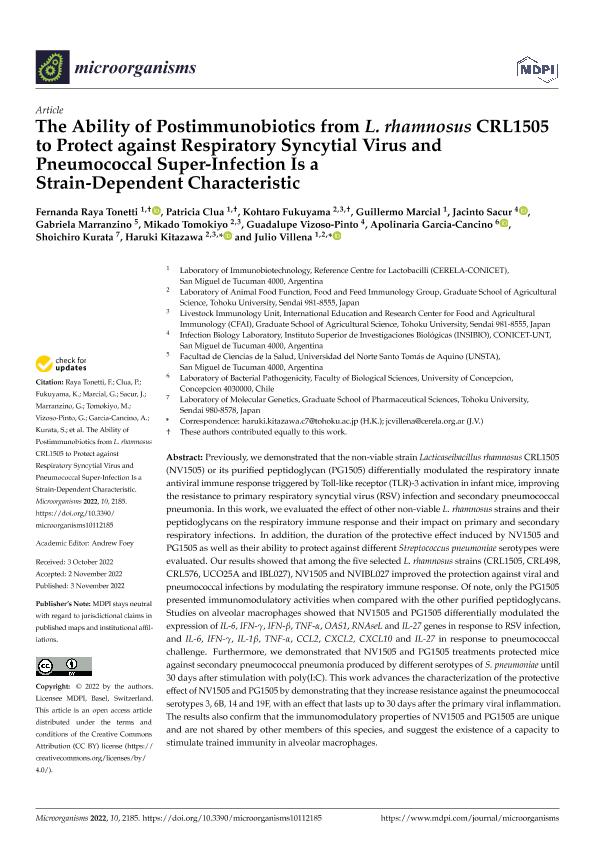Artículo
The Ability of Postimmunobiotics from L. rhamnosus CRL1505 to Protect against Respiratory Syncytial Virus and Pneumococcal Super-Infection Is a Strain-Dependent Characteristic
Raya Tonetti, María Fernanda ; Clua, Maria Patricia
; Clua, Maria Patricia ; Fukuyama, Kohtaro; Marcial, Guillermo Emilio
; Fukuyama, Kohtaro; Marcial, Guillermo Emilio ; Sacur, Jacinto Alfredo
; Sacur, Jacinto Alfredo ; Marranzino, Gabriela
; Marranzino, Gabriela ; Tomokiyo, Mikado; Vizoso Pinto, María Guadalupe
; Tomokiyo, Mikado; Vizoso Pinto, María Guadalupe ; Garcia Cancino, Apolinaria; Kurata, Shoichiro; Kitazawa, Haruki; Villena, Julio Cesar
; Garcia Cancino, Apolinaria; Kurata, Shoichiro; Kitazawa, Haruki; Villena, Julio Cesar
 ; Clua, Maria Patricia
; Clua, Maria Patricia ; Fukuyama, Kohtaro; Marcial, Guillermo Emilio
; Fukuyama, Kohtaro; Marcial, Guillermo Emilio ; Sacur, Jacinto Alfredo
; Sacur, Jacinto Alfredo ; Marranzino, Gabriela
; Marranzino, Gabriela ; Tomokiyo, Mikado; Vizoso Pinto, María Guadalupe
; Tomokiyo, Mikado; Vizoso Pinto, María Guadalupe ; Garcia Cancino, Apolinaria; Kurata, Shoichiro; Kitazawa, Haruki; Villena, Julio Cesar
; Garcia Cancino, Apolinaria; Kurata, Shoichiro; Kitazawa, Haruki; Villena, Julio Cesar
Fecha de publicación:
03/11/2022
Editorial:
Multidisciplinary Digital Publishing Institute
Revista:
Microorganisms
ISSN:
2076-2607
Idioma:
Inglés
Tipo de recurso:
Artículo publicado
Clasificación temática:
Resumen
Previously, we demonstrated that the non-viable strain Lacticaseibacillus rhamnosus CRL1505 (NV1505) or its purified peptidoglycan (PG1505) differentially modulated the respiratory innate antiviral immune response triggered by Toll-like receptor (TLR)-3 activation in infant mice, improving the resistance to primary respiratory syncytial virus (RSV) infection and secondary pneumococcal pneumonia. In this work, we evaluated the effect of other non-viable L. rhamnosus strains and their peptidoglycans on the respiratory immune response and their impact on primary and secondary respiratory infections. In addition, the duration of the protective effect induced by NV1505 and PG1505 as well as their ability to protect against different Streptococcus pneumoniae serotypes were evaluated. Our results showed that among the five selected L. rhamnosus strains (CRL1505, CRL498, CRL576, UCO25A and IBL027), NV1505 and NVIBL027 improved the protection against viral and pneumococcal infections by modulating the respiratory immune response. Of note, only the PG1505 presented immunomodulatory activities when compared with the other purified peptidoglycans. Studies on alveolar macrophages showed that NV1505 and PG1505 differentially modulated the expression of IL-6, IFN-γ, IFN-β, TNF-α, OAS1, RNAseL and IL-27 genes in response to RSV infection, and IL-6, IFN-γ, IL-1β, TNF-α, CCL2, CXCL2, CXCL10 and IL-27 in response to pneumococcal challenge. Furthermore, we demonstrated that NV1505 and PG1505 treatments protected mice against secondary pneumococcal pneumonia produced by different serotypes of S. pneumoniae until 30 days after stimulation with poly(I:C). This work advances the characterization of the protective effect of NV1505 and PG1505 by demonstrating that they increase resistance against the pneumococcal serotypes 3, 6B, 14 and 19F, with an effect that lasts up to 30 days after the primary viral inflammation. The results also confirm that the immunomodulatory properties of NV1505 and PG1505 are unique and are not shared by other members of this species, and suggest the existence of a capacity to stimulate trained immunity in alveolar macrophages.
Archivos asociados
Licencia
Identificadores
Colecciones
Articulos(CERELA)
Articulos de CENTRO DE REFERENCIA PARA LACTOBACILOS (I)
Articulos de CENTRO DE REFERENCIA PARA LACTOBACILOS (I)
Articulos(ICYTAC)
Articulos de INST. DE CIENCIA Y TECNOLOGIA DE ALIMENTOS CORDOBA
Articulos de INST. DE CIENCIA Y TECNOLOGIA DE ALIMENTOS CORDOBA
Articulos(INSIBIO)
Articulos de INST.SUP.DE INVEST.BIOLOGICAS
Articulos de INST.SUP.DE INVEST.BIOLOGICAS
Citación
Raya Tonetti, María Fernanda; Clua, Maria Patricia; Fukuyama, Kohtaro; Marcial, Guillermo Emilio; Sacur, Jacinto Alfredo; et al.; The Ability of Postimmunobiotics from L. rhamnosus CRL1505 to Protect against Respiratory Syncytial Virus and Pneumococcal Super-Infection Is a Strain-Dependent Characteristic; Multidisciplinary Digital Publishing Institute; Microorganisms; 10; 11; 3-11-2022; 1-22
Compartir
Altmétricas



